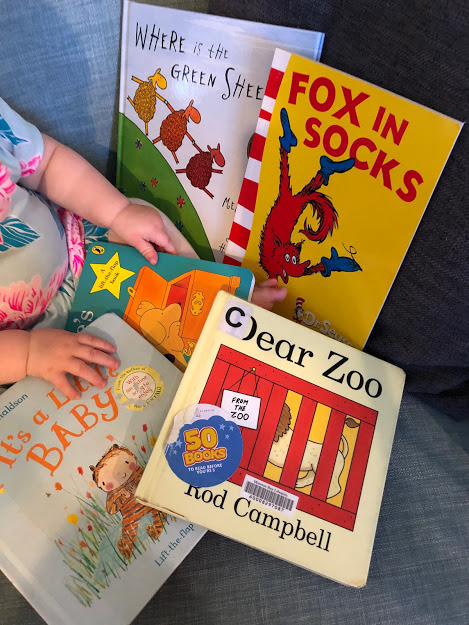By Emma Thomas Full-time mum to an 8-month-old girl, part-time blogger, with a background as a Kindy Teacher/Director
Did you know that reading your child five books each day will expose them to over a million words by the time they reach Kindy? A recent study published in the Journal of Development and Behavioural Pediatrics looks at the reading practices of parents and children in the first five years. ( https://journals.lww.com/jrnldbp/Citation/2019/06000/When_Children_Are_Not_Read_to_at_Home__The_Million.9.aspx)
Reading with your child is one of the best predictors of academic success in schooling. Developing a love of reading in the early years is critical to lay the neural pathways for future learning. We all know that reading to your children is important and understand that it has great long term benefits but some days reading five books just isn’t practical! I’d like to suggest some easy ways to make reading enjoyable and achievable to help us give our children the best start they can get.
‘The Five Day Challenge’
If reading five books to your child every day seems like too much, could you commit to reading the same five books for just five days? And can you do this without going crazy?
It seems that children often want to read the same stories over and over again, but before you throw your hands up in despair remember: this is actually good for them. The developing brain learns through repetition. As children hear a story again and again they become masters of it and this strengthens their confidence and understanding of the story structure.
I have seen more than one child who has found their favourite story at the library and wanted to borrow it out, even though they already have this book at home!
For my attempt at the challenge I have chosen some well-known classics:
- ‘Dear Zoo’ by Rod Campbell
- ‘Fox in Socks’ by Dr Seuss
- ‘It’s a Little Baby’ by Julia Donaldson
- ‘Where is the Green Sheep?’ By Mem Fox
- ‘Where’s Spot?’ By Eric Hill
My daughter is currently loving books with a strong rhythm and rhyme. She particularly enjoys listening to her dad struggle through the tongue twisters in Fox in Socks! Over the last month she has grasped the concept of ‘peek-a-boo’ and is really enjoying ‘lift-the-flap’ books.

Make your own rules and routines
Children find comfort and security in rhythm and routine, even simple routines like story time. Plus, children learn best when they feel safe and secure. Reading stories before bed works well as part of a night-time routine for a lot of children but do what works for you and your child! Maybe your child would rather read in the morning or just before dinner.
If you are sick of reading the same books each night, create a rule where your child chooses one story and you get to choose one story. Or a rule where you will only read the same book twice each day.
Model reading
Let your child see you reading. Reading doesn’t have to be sitting down with a novel. Show your child when you are reading a recipe, a shopping list or a magazine. If you read novels on your phone share this with your child so they can see the positive side of technology.
Keep reading fun and relaxed
Don’t stress if your child won’t sit still while you read to them. Try different times of day, different types of books or a different environment. With babies and toddlers, I suggest sitting on the floor and allowing them to move back and forth off your lap while you read. For an older child you can make reading special by snuggling up in the parents’ bed or taking books outside.
I am the eldest of five children, so I remember listening to my mum and dad read to my siblings when I had grown out of nightly story time. I fondly remember many of the stories from my childhood and the warm, comfortable feeling of sitting together reading with my family.

Have a literacy rich house
Have reading material everywhere! Think about the age of your child and what is appropriate for them. For me at the moment with my eight-month-old I have: a bookshelf in her bedroom with stories that we read before bed, a basket of board books that she can play with on her mat (although she has started eating these!), a scrunchy textured book for in the car, a plastic book for in the bath and a book with a strap for in the pram. I also keep a board book in the nappy bag for when we are out.
Think about what sort of reading material your child will enjoy and where you could keep it. If they have a cubby house or an outdoor play area could you keep books there? Does your family have any special books that can be kept up high and brought out on specials occasions? Would your child be interested in a magazine subscription?
Try audiobooks or podcasts for car trips and find YouTube videos of your child’s favourite story when you need a few minutes peace.
Visit your local library!
Local libraries are the most amazing places and not full of dusty rows of drab books that you may remember from your childhood. You can borrow books (obviously) but many have toys, DVDs, and magazines for hire. They also run great events and are often located in or near a park.
Why is reading so important?
- Being able to predict (what comes next in a story, what sounds make up a word) is an important early literacy skill
- It teaches children to connect words and sounds
- Reading together facilities strong emotional connection
- It is calming and relaxing
- Stories provide teaching and learning opportunities
- It develops listening skills
Check out the ‘Let’s Read’ website for more great ideas about reading with your child!






